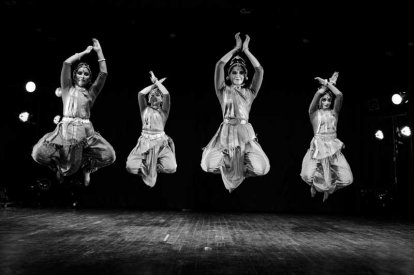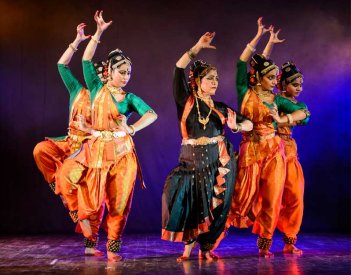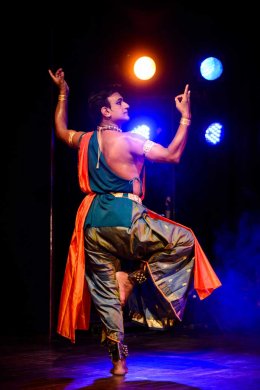
|   |

|   |
 e-mail: sunilkothari1933@gmail.com Vanashree Rama Rao's emergence as choreographer November 20, 2016 The title of the performance at IIC Fountain Lawns, presented by India International Centre, supported by Takshila Education Society was 'Timeless tales of Gods and Goddesses, Men and Demons, Love and Devotion', conceived and choreographed by Kuchipudi dancer Vanashree Rama Rao. It was a compact and thoroughly well rehearsed presentation performed by professional dancers from three different streams of Indian classical dance - Mayurbhanj Chhau, Bharatanatyam and Kuchipudi. The teamwork was exemplary with vocals by K. Venkatesh, Dr. S. Vasudevan, flute by Rajat Prasanna, violin by Master Raghavendra and percussion instruments by R. Keshavan who handled mridangam, tabla, pakhavaj, khol, and kanjira for dramatic effect. Nattuvangam was by Dr. S. Vasudevan. The music was recorded. Under the open sky in balmy winter weather the presentation looked impressive with imaginative and dramatic lighting. The choreography inputs for Bharatanatyam were by Vasudevan, for Mayurbhanj Chhau by Kuleshwar Kumar Thakur and two Chhau dancers Anurag Khichi and Arjun Dev Malik, and for Kuchipudi by Vanashree. The overall choreography was finalized by Vanashree Rao. 

The three main stories round which the performance was woven were Tripurasurasamhara, Karna and Durga. Tripurasurasamhara was sourced from Shivamahapurana and other puranas. It had breathtaking performances by three asuras, sons of Tarakasura -Tarakaksha, Viryavan and Vidyunmali - enacted by Chhau dancers who with their ufli and topka vocabulary, aerial jumps and difficult body movements, coupled with yoga and martial arts practices brought element of virility and demonic energy, while fighting with Lord Shiva, who with army of Meru mountain, chariot of Sun and Moon, pinaka weapon of Vasuki, Brahma as charioteer and Vishnu as arrow defeated the three asuras. The Ananda tandava was performed by Vasudevan and four Kuchipudi dancers competently. Vanashree had studied it under late Vempati Chinna Satyam and followed it in her choreography faithfully. The combination of Bharatanatyam by Vasudevan and four Kuchipudi dancers Ayana Mukherjee, Aanjini Nair, Moutishi Majumdar and Gulbin Sultana, disciples of Vanashree from branch of her dance school at JNU, was scintillating, with typical grace, lilt and verve of Vempati's bani. It was set to melodious swaralahari with raga Vasanta and Vijaynagari. Vigorous movements by Vasudevan were most impressive as were graceful movements of the Kuchipudi dancers. Vanashree presented Purandara Dasa's well known "Jagadodharana" song as a Sutradhara, describing how Yashoda was bringing up Krishna with vatsalya, not knowing what a divine person he was. Interesting enactment of Krishna by four Kuchipudi dancers was choreographed imaginatively showing him as a child, grown up Krishna breaking pots of Gopis, jumping into Yamuna and subjugating serpent Kaliya. She introduced from Mahabharata, story of Krishna as a messenger going to court of Dhritarashtra begging for five villages for the Pandavas, Duryodhana disregarding him and asking soldiers to tie him up and failing as Krishna took his Vishwarupa form. Mother Yashoda was holding such a Lord Krishna in her arms and how he saved Draupadi from humiliation. She also incorporated Dashavatara towards end for the word 'Jagadodharana' as sanchari bhava. The heart-rending story of Karna, Daneshwari, who never hesitated when anyone came to him to ask anything, unhesitatingly when Indra came in disguise of a Brahmin he gave away his kavach, armour and also golden earrings to him, so that he can be defeated in war by Arjuna, was enacted with deep understanding and feeling by Vasudevan. Krishna encouraging Arjuna to kill Karna reminding Karna of his disregard for dharma when Draupadi was humiliated and when Abhimanyu was killed, did not give Karna chance to raise the wheel of chariot which was stuck in the ground. Infuriated by remembering how his son Abhimanyu was killed, Arjuna shot arrows at Karna and killed him. The episode is so moving that one sympathises with Karna for the injustice done to him. Vanashree as Krishna, charioteer for Arjuna in battlefield, spoke in English about dharma to Karna, which did not go well with the production, as the story was told in advance. Dialogue even in Sanskrit would have been more appropriate.  Dr. Vasudevan as Shiva The finale Durga brought to the fore, the images of multi-armed goddess, in battle with Mahishasura and his army. It was tour de force. Vanashree and four dancers in Kuchipudi created several tableaus of the goddess in multiple forms, attacking Mahishasura played by Vasudevan, and Chhau dancers as his army performing in Chhau, excellent aerial and acrobatic movements to ward off attack by Durga. The prayer "Ya Devi sarva bhuteshu" filled the open air with various instruments creating dramatic impact. These familiar episodes invariably evoke a feeling of bhakti, and succeed with faultless dancing, excellent lighting and powerful music. The mangalam was in praise of Hari and Hara juxtaposing various aspects of Krishna, with "Kasturi Tilakam" shloka, and for Shiva, prayer mentioning his adornment of moon on his locks, Ganga flowing from Jata, serpents as his ornaments and his bhuta ganas, performed by Chhau dancers. Vasudevan as Krishna with four Kuchipudi dancers created pleasant images, Krishna dancing with them in circle, and adorning himself with peacock feather, pitambar, holding flute and so on. Vanashree impersonating as Shiva enacted suggestion of Ardhanarishwara, wearing tiger skin, having Nandi as his vahana, creating visuals alternatively for Hari and Hara and ending with both gods coming together. The costumes designed by Sandhya Raman gave dancers enough scope for movement and looked elegant. The lighting and sound by Surendra Kulasrestha were effective and lit up the gods and goddesses with appropriate lighting. The attempt to dovetail three dance forms for the mythological stories was successful as the episodes were presented in a seamless manner, evoking rasa as the stories are well known and communicate immediately to the audience. Besides being a seasoned solo exponent, Vanashree has been working hard to explore the classical dance forms with excellent music.  Dr. Sunil Kothari is a dance historian, scholar, author and critic. He is honored with Padma Shri, Sangeet Natak Akademi award and Senior Critic Award from Dance Critics Association, NYC. Post your comments Please provide your name and email id when you use the Anonymous profile in the blog to post a comment. All appropriate comments posted with name & email id in the blog will also be featured in the site. |